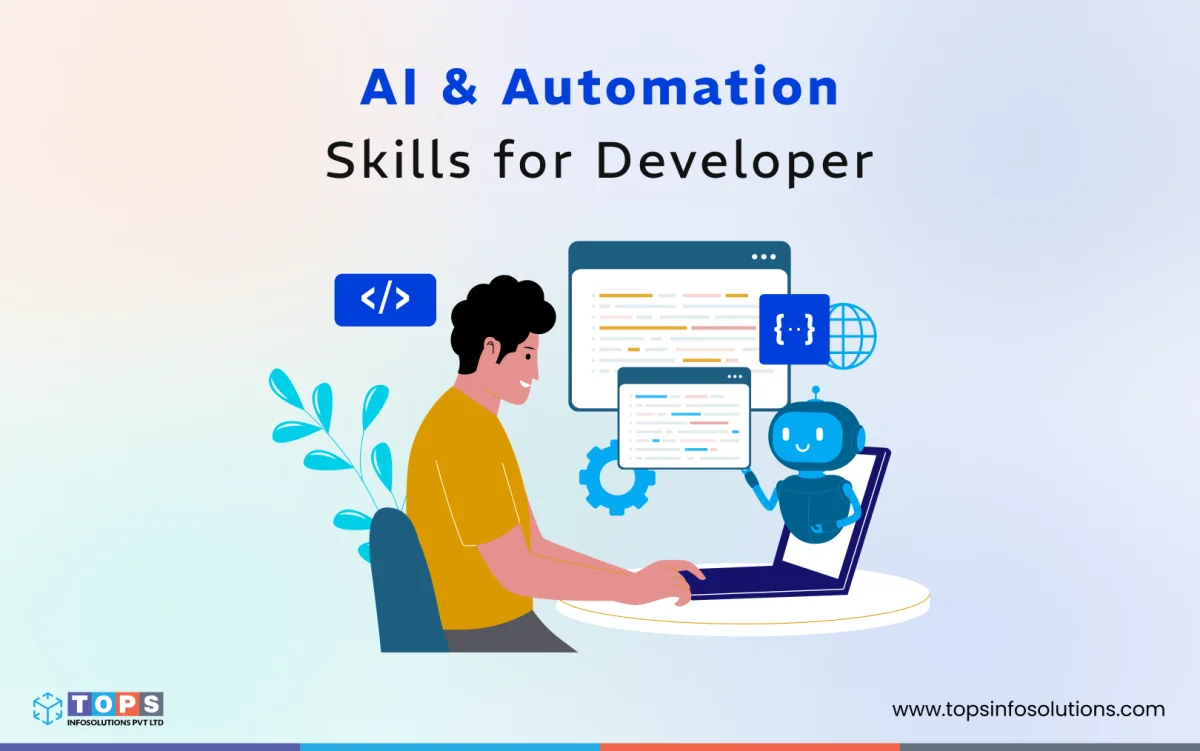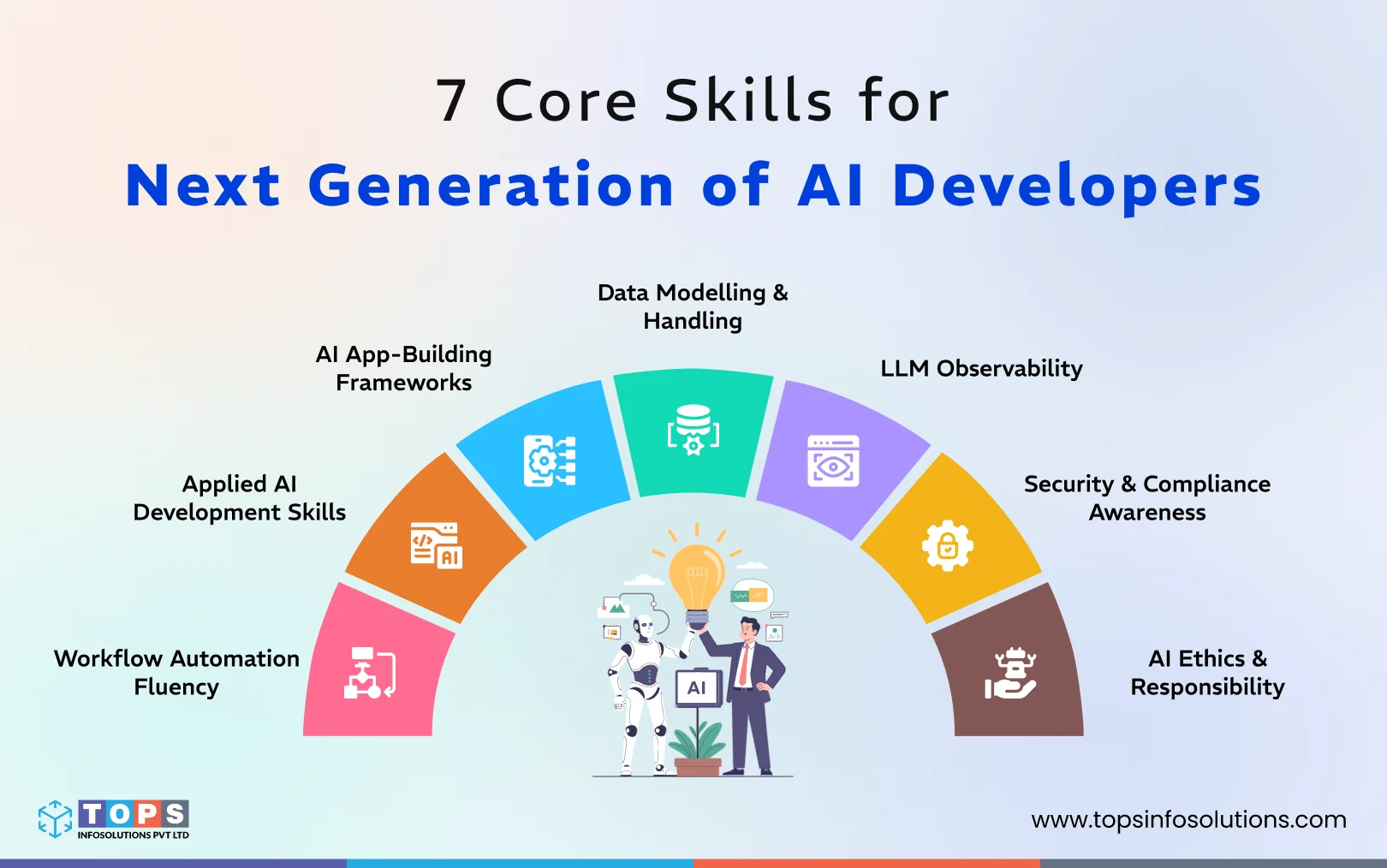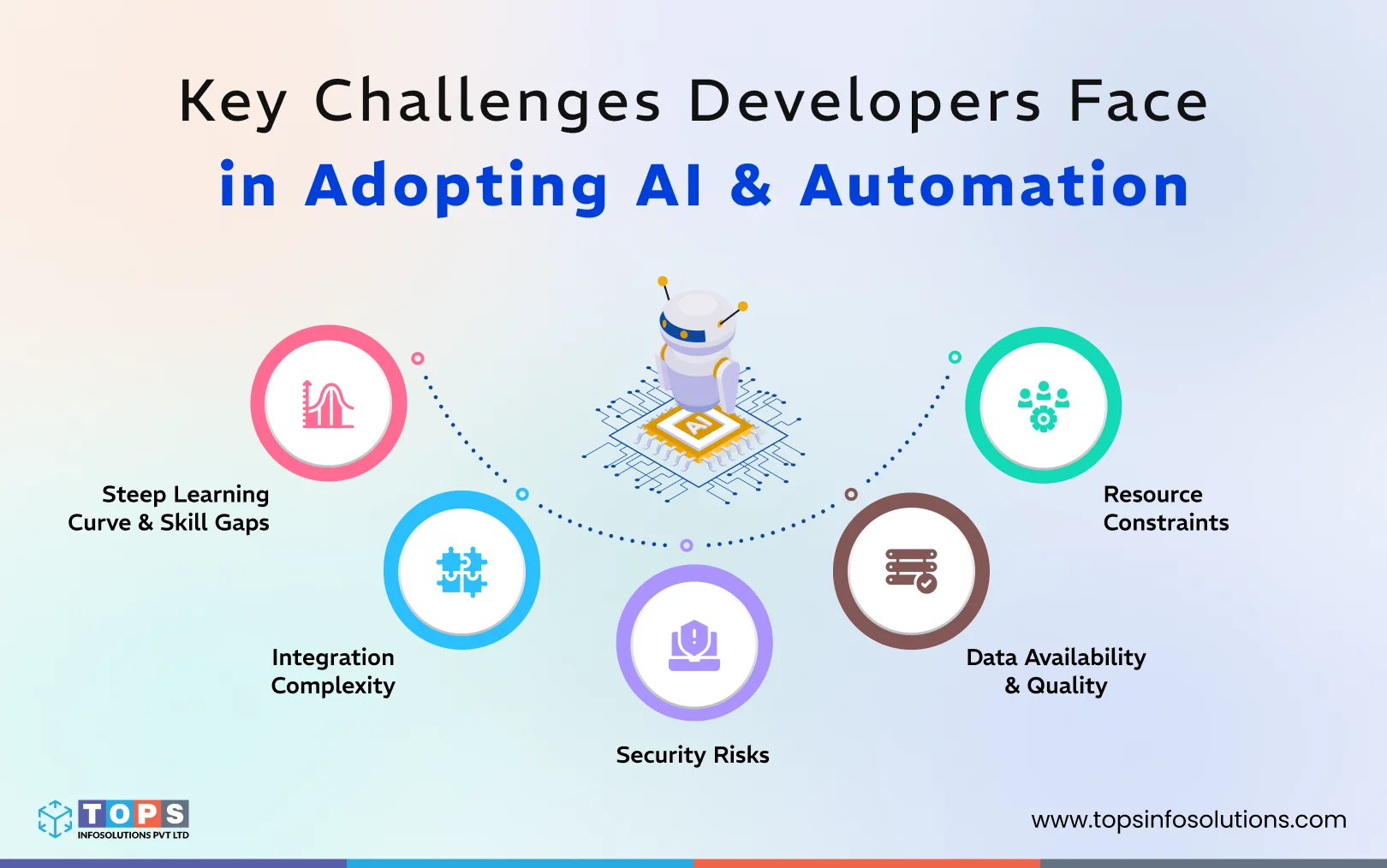Table of Contents
Bridging AI and Automation: What Developers Must Learn Now

AI is everywhere in software development. It’s accelerating code generation, streamlining workflows, and transforming how software is built.
But for developers and tech leaders, this sparks a crucial question: What next?
AI is redefining what it means to be a developer. So rather than resisting the change, you evolve with it. Latest research suggests that more than 90% of software engineering firms have adopted AI into their operations and offerings
This transformation calls for a new technical skill set that blends AI, automation, and software engineering.
In this blog, we’ll explore the developer skills for AI automation and the challenges developers face as they bridge AI and automation.
Core Skill Areas Developers Must Master
Staying relevant in software engineering means choosing to hire AI developers who can bring this intelligence into everyday engineering work. They need a toolkit shaped around modern AI and automation, and this blog walks you through the skills that matter most.

1. Workflow automation fluency
Workflow automation connects apps, APIs, and data so processes run without human intervention. AI is taking this further by automating decisions, predicting next steps, and handling dynamic inputs through platforms like n8n, Make, and Zapier.
For instance, consider an AI-powered support workflow that can classify incoming tickets, prioritize urgent issues, and even suggest responses before routing them to the right agent. With n8n and Zapier, developers can embed AI steps to analyze, predict, or act dynamically.
Developers who understand how to design and manage these intelligent workflows can boost efficiency, reduce manual overhead, and create systems that scale effortlessly. It’s a foundational skill for anyone building in an AI-driven ecosystem.
What developers need to learn:
- Design AI-powered workflows that connect multiple tools, APIs, and data sources
- Build triggers and conditions to automate repetitive development or business tasks
- Monitor workflow performance and handle error recovery or reruns automatically
Tools to master: n8n, Make, Zapier, Airplane, and Pipedream.
2. Applied Artificial Intelligence development skills
AI is no longer confined to data science. It’s becoming an everyday development tool. With applied AI, developers need to expand their skillset using pre-trained models, APIs, and frameworks to bring intelligence directly into applications.
Developers can integrate vision, speech, or language models through platforms like OpenAI, Hugging Face, or Google Vertex AI without needing to train models from scratch. For example, an app can analyze customer feedback in real time using sentiment analysis or auto-generate product recommendations based on user behavior. These small integrations create a big leap in user experience and automation depth.
What developers need to learn:
- Build AI-driven features like chatbots, recommendation engines, or sentiment analysis
- Integrate pre-trained AI models into apps using APIs or SDKs
- Manage model inputs and outputs to ensure accuracy and relevance
Tools to master: OpenAI API, Hugging Face, Vertex AI, Anthropic Claude, and Azure AI Studio.
3. AI App-building frameworks
We cannot talk about AI development without AI app-building frameworks. Building AI-powered mobile app is about creating an ecosystem where that model interacts with data, APIs, and logic in meaningful ways.
That’s where AI app-building frameworks come in. They give developers the structure to connect large language models with external systems, manage context, and build intelligent apps faster.
Frameworks like LangChain, LlamaIndex, and Dust simplify the complex parts of AI development like chaining model calls, handling prompts, and retrieving relevant data when the model needs context.
What developers need to learn:
- Use frameworks to connect LLMs with APIs, databases, and custom business logic
- Build modular AI apps using components like AI agents, memory, and retrievers
- Implement retrieval-augmented generation (RAG) for context-rich, accurate responses
Tools to master: LangChain, LlamaIndex, Dust, Gradio, Streamlit, and Hugging Face Spaces.
4. Data modelling & handling
While on the surface, AI technologies look nothing less than science fiction, in the end, it is all just an intricate web of data that makes it all possible. Developers need to know how to collect, organize, and prepare data so models can actually make sense of it and learn from it.
It’s about feeding data into a model and designing the right data pipeline. Developers need to have an understanding of cleaning messy datasets, normalizing formats, tagging unstructured text, and ensuring data flows smoothly between tools and APIs.
What developers need to learn:
- Design robust data pipelines for AI workflows
- Preprocess and label data for model training and inference
- Manage both structured and unstructured datasets efficiently
Tools to master: Pandas, Snowflake, Databricks, Pinecone, and Hugging Face Datasets.
5. LLM Observability
Large Language Models are at the core of generative AI technologies. As a developer, it is essential to understand the workings of LLM and how to analyze the internal flow in real time. You get to know LLM behavior through observability metrics like response time, throughput, and model accuracy.
Developers are already aware of debugging. This is just doing it on a much larger and dynamic scale. For example, a developer working on an AI-driven support chatbot can use observability tools to track metrics like response relevance and hallucination rates to detect early signs of degradation.
What developers need to learn:
- Track and evaluate model outputs for quality and consistency
- Set up alerts and dashboards to catch performance anomalies
- Use observability data to refine prompts, retrain models, and improve responses
Tools to master: LangSmith, Langfuse, Arize Phoenix, Datadog, and Helicone
6. Security & compliance awareness
With AI, the stakes are higher than ever with security. Think about it. You’re dealing with sensitive data that’s integrated into various business workflows. Developers need to understand how to build a layer of security while using AI so that it can protect data, models, and APIs against misuse, leaks, and unauthorized access.
Automation in software development with AI now has potential exposure points, and securing them is part of the job. Beyond protection, there’s a growing responsibility to comply with evolving AI governance standards like GDPR, CCPA, and the upcoming EU AI Act.
What developers need to learn:
- Secure API keys, data pipelines, and model endpoints.
- Implement authentication, encryption, and access controls in AI workflows.
- Ensure model transparency and explainability for compliance audits.
- Latest AI governance standards for compliance
Tools to master: Vault by HashiCorp, AWS Identity & Access Management (IAM), and Lacework.
7. AI ethics & responsibility
Sure, technical skills are important if you want to move forward as an AI developer. But it is all in vain if you don’t consider the ethics that come with having this skillset. There’s a moral responsibility when you’re dealing with shaping decisions that affect fairness, privacy, and trust.
As AI doesn’t understand moral responsibility, developers need to step in to make fairer decisions. For example, consider an AI hiring app that screens candidates who aren’t trained on balanced datasets to avoid gender or racial bias. Developers need to think critically about how their models learn, what data they use, and how outputs are presented. Responsible AI is as much about prevention as it is about transparency and accountability.
What developers need to learn:
- Evaluate data sources for bias and fairness
- Implement explainability features in AI systems
- Create guardrails to prevent misuse or unethical outcomes
Tools to master: IBM AI Fairness 360, Google’s What-If Tool, and Hugging Face Evaluate
Challenges in Adopting AI and Automation for Developers
While AI applications are the future, integrating them into developers’ skillset isn’t a cakewalk. It requires both technical and organizational readiness. There are some hurdles developers may face as they adapt to this new paradigm.

1. Steep learning curve and skill gaps
While there’s a lot of talk about AI, very few know how to use AI as a tool or actually build productive workflows. AI demands specialized skills that many don’t possess, leading to possible skill gaps. Majorly, the bottlenecks arise when automation tools for developers evolve faster than training materials can catch up.
How to fix:
It’s crucial to bring about a cultural change before investing in AI education. Having a team that is open to upskilling learn faster. Provide training and resources to your current employees, work with external AI consultants to access expertise, and invest in AI education and certification programs to build a skilled workforce.
2. Integration complexity
One of the biggest challenges that developers may encounter is bringing AI into legacy systems. Models need clean data, stable APIs, and cloud environments that can handle new workloads. If the current architecture isn’t designed for AI-driven tasks, developers’ tasks can be delayed and need rework.
How to fix:
Assessing the existing infrastructure makes the rest of the process much easier. Developers can then start with smaller, manageable AI implementations that can be easily integrated. Clear documentation, stronger API contracts, and closer collaboration between backend, frontend, and data teams help create a structure where AI fits naturally instead of feeling bolted on.
3. Data availability & quality
AI entirely relies on data. And while there is an abundance of data available, most of it is scattered, outdated, or inconsistent. This slows down every part of the process. Models struggle to perform when the inputs are incomplete, poorly labeled, or stored in formats that don’t work well for training or retrieval.
For developers, this means that they have to spend loads of time gathering, cleaning, and structuring data to ensure that whatever they build makes sense and can function seamlessly.
How to fix:
Developers can make steady progress when they start by cleaning what they already have instead of chasing more data. Focus on data cleaning to ensure your data is error-free and consistent. Ensure that whatever data you have represents a wide range of scenarios to avoid bias. Centralizing key sources, adding clear labels, and setting simple validation rules help models behave far more predictively.
4. Security risks
Since a lot of AI technologies are in their nascent stages, there aren’t many regulations for data privacy. Models interact with sensitive data more often, automation workflows move information across tools, and third-party APIs become part of the pipeline.
This creates entry points that didn’t exist before. For developers, it’s a concern point since they have to worry about leaks, unauthorized access, and prompt-based attacks that expose internal details.
How to fix:
Developers need to run regular audits and encrypt the data that flows into the models. Enable strict permissions on who can access what and use filters as guardrails to prevent harmful inputs. When developers follow these habits consistently, AI features stay powerful without putting sensitive information in danger.
5. Resource constraints
Finally, it’s obvious that every AI endeavor you decide to take on comes with a price tag. Not just that, smaller teams often realize they don’t have enough skilled people to manage pipelines, optimize workloads, or handle retraining cycles. Even well-funded teams need to balance experimentation with cost control. This makes it tough to scale AI features without stretching resources thin.
How to fix:
Using managed AI services and prebuilt models can help keep expenses in check. Developers also gain an advantage when they automate routine tasks, monitor usage patterns, and run lightweight models where possible. This helps teams build smarter AI systems without draining budgets or overwhelming their workforce.
Starting your AI journey with TOPS
AI is redefining software development, and for developers, it calls for a major skill upgrade. Mastering automation, understanding models, improving data pipelines, and building responsibly all play a part in creating smarter products. The challenges are real, yet each one becomes manageable with steady learning and the right support.
If you’re looking to move forward with your AI journey to build agentic AI and applied AI solutions, TOPS can help. Our AI developers bring hands-on experience across automation, model integration, and end-to-end implementation. They guide you through adoption, strengthen your systems, and help you launch AI features with confidence.
